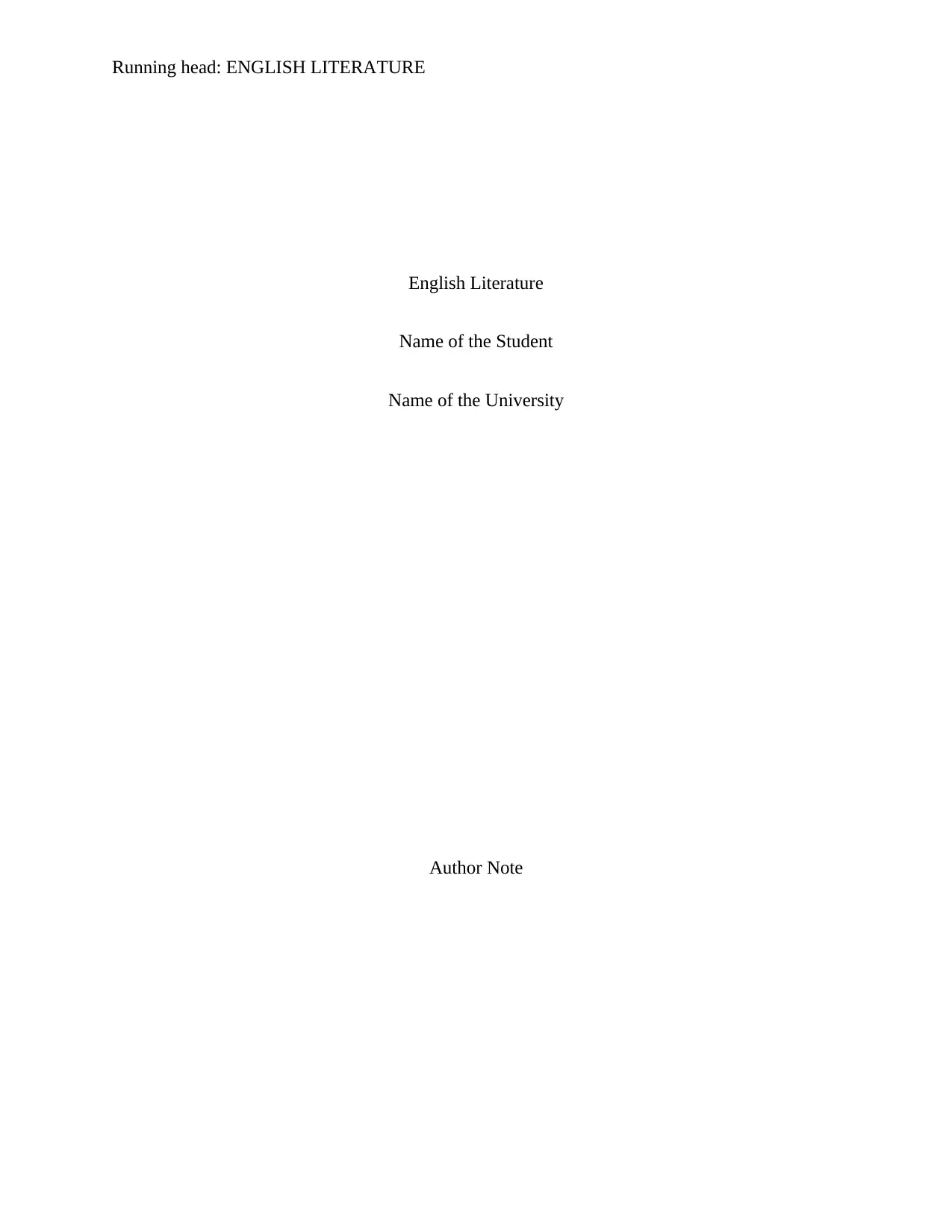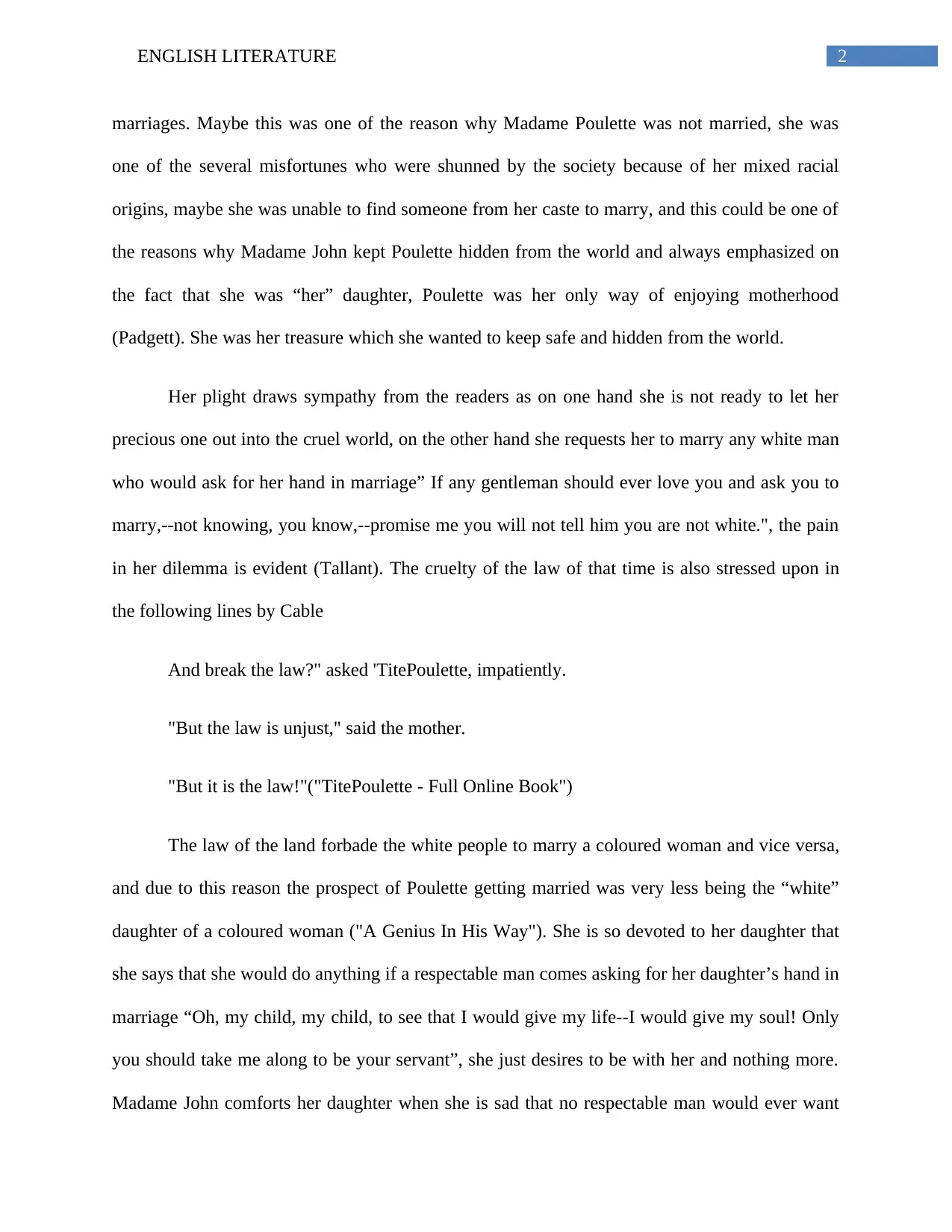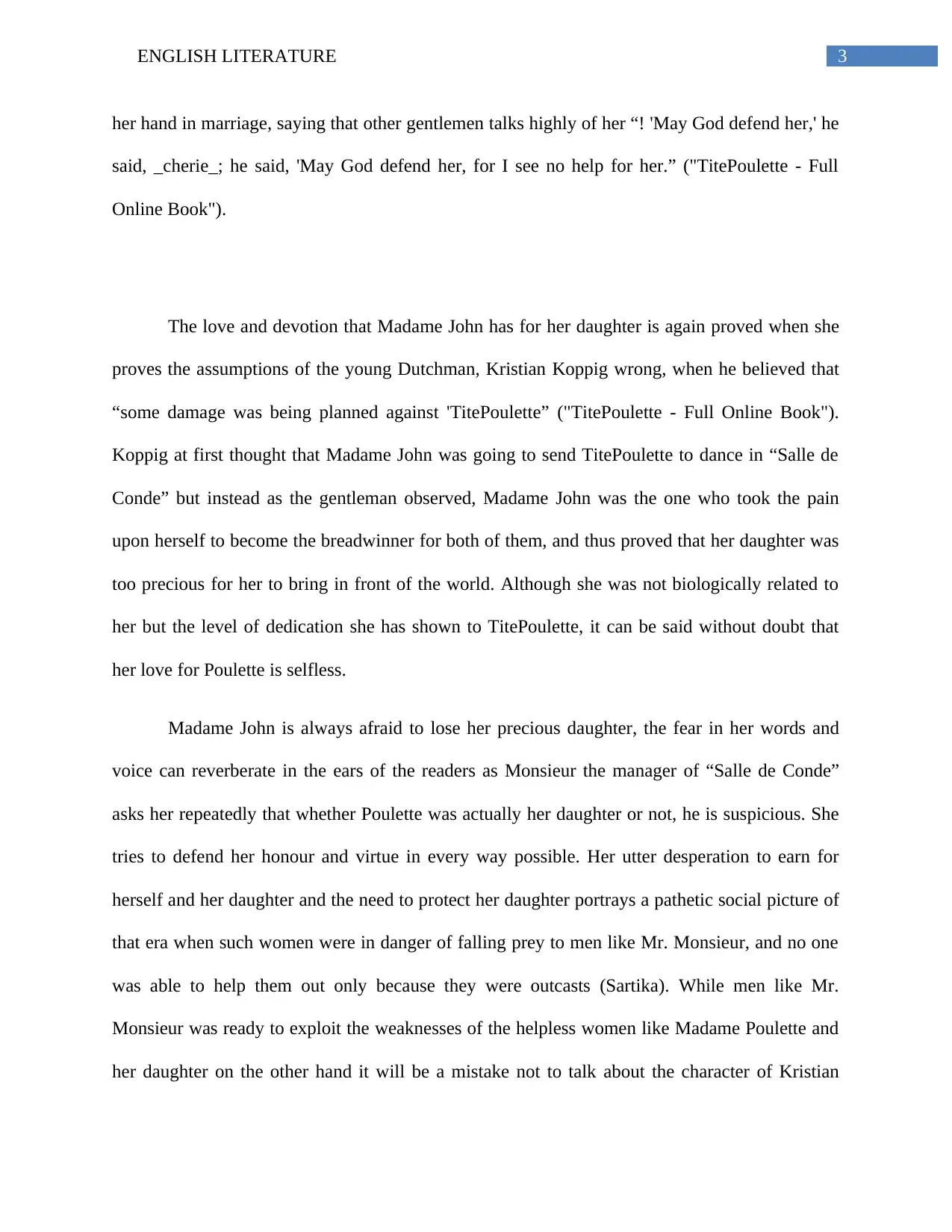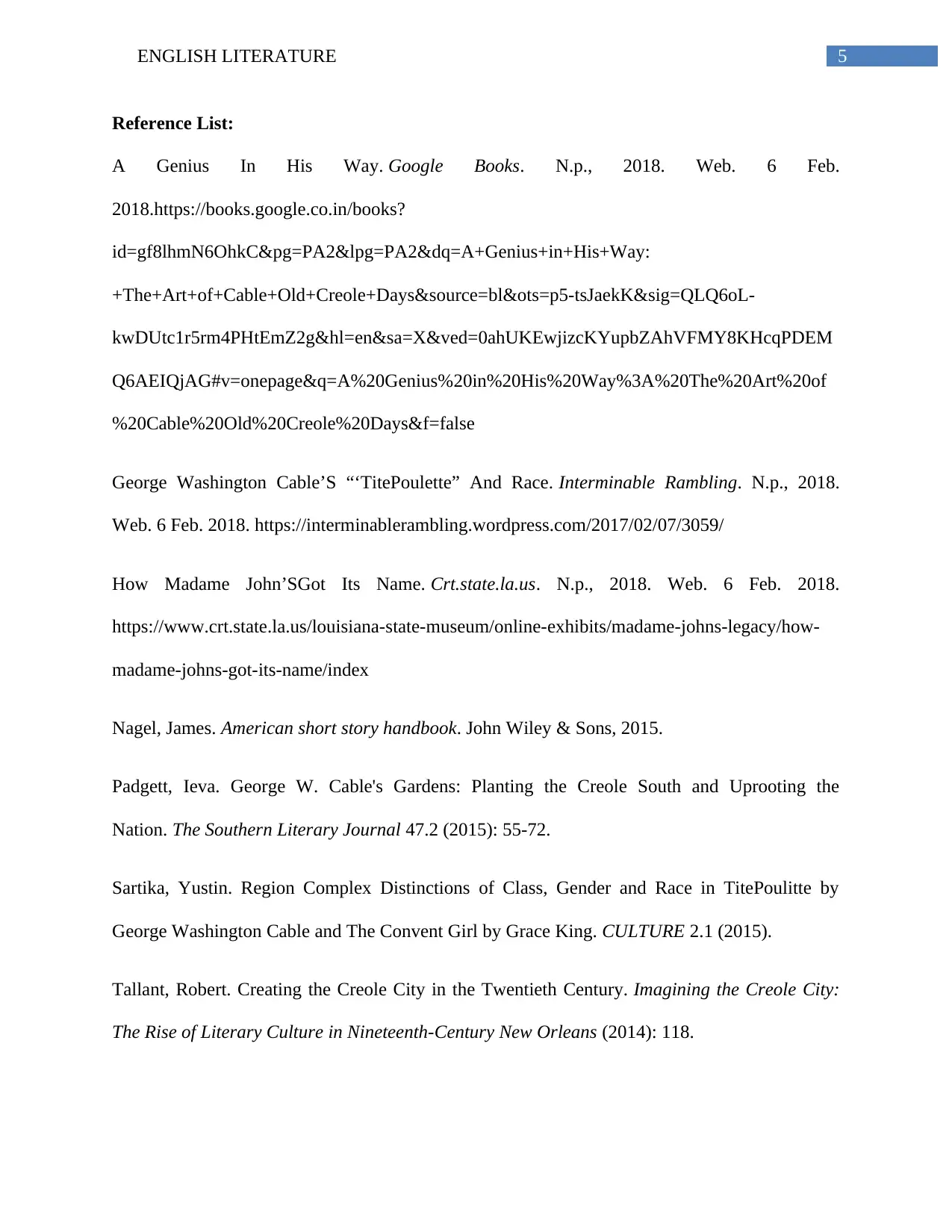George Cable's 'Tite Poulette': A Deep Dive into Racial Discrimination
VerifiedAdded on 2023/06/15
|7
|1714
|54
Essay
AI Summary
This essay delves into George Washington Cable's 'Tite Poulette,' exploring the prevalent racial discrimination in 19th-century America, particularly in New Orleans. It examines the plight of quadroon and octoroon women, highlighting the story of Madame John and her adopted daughter, Tite Poulette, who faces societal prejudice due to her mixed racial heritage. The essay analyzes Cable's portrayal of racial bias, the legal restrictions on interracial marriage, and the characters' struggles within a racially divided society. It further discusses Madame John's selfless love and sacrifices to protect Tite Poulette from exploitation, contrasting it with characters like Kristian Koppig, who offers support, and Mr. Monsieur, who represents the exploitative forces of the time. Ultimately, the essay underscores how racial prejudice forces Madame John to reveal Tite Poulette's true parentage to secure her future.

Running head: ENGLISH LITERATURE
English Literature
Name of the Student
Name of the University
Author Note
English Literature
Name of the Student
Name of the University
Author Note
Paraphrase This Document
Need a fresh take? Get an instant paraphrase of this document with our AI Paraphraser

1ENGLISH LITERATURE
George Washington Cable was one of the most notable novelists of America in the late
19th century, his works chiefly comprised of literature based on the topic of racism and the
treatment of the coloured people and the mixed races during that period of time. He wrote
several articles criticizing the bias that existed in the society based solely on the colour of a
person’s skin. The story “TitePoulette” in the most realistic manner portrays the racial
discrimination that existed in the society("George Washington Cable’S “‘TitePoulette” And
Race"). Cable said that he got the idea of the story after seeing the plight of the quadroon and
octoroon women in New Orleans they had very little rights and were often unmarried aslaw
banned inter-caste marriage("How Madame John’S Got Its Name"). In this story, Madame John
is described as a “ apalish handsome woman” she was a quadroon, he was one quarter black, a
part of mixed race which was common in New Orleans. One day she had a Spanish man and a
woman at her house and they fell sick of flu and they died leaving their only child. Madame John
raised her as her own daughter and gave her a pet name TitePoulette.
Right from the beginning everyone had doubts about the fact that whether Poulette was
actually her daughter or not as Madame John was “ You would hardly have thought of her being
"colored." Though fading, she was still of very attractive countenance, fine, rather severe
features, nearly straight hair carefully kept, and that vivid black eye so peculiar to her kind”
("TitePoulette - Full Online Book"). Her daughter Poulette on the other hand was “So beautiful,
beautiful, and beautiful! White?--white like a water lily! White--like a magnolia!"("TitePoulette -
Full Online Book"). The men would praise her beauty and were mesmerized by her beauty, yet
no one would dare to ask for her hand from Madame Poulette as she was the daughter of a
quadroon or a one quarter black individual (Nagel). There was a fine line between the various
races that existed at that time in the society, even there was laws forbidding inter caste or race
George Washington Cable was one of the most notable novelists of America in the late
19th century, his works chiefly comprised of literature based on the topic of racism and the
treatment of the coloured people and the mixed races during that period of time. He wrote
several articles criticizing the bias that existed in the society based solely on the colour of a
person’s skin. The story “TitePoulette” in the most realistic manner portrays the racial
discrimination that existed in the society("George Washington Cable’S “‘TitePoulette” And
Race"). Cable said that he got the idea of the story after seeing the plight of the quadroon and
octoroon women in New Orleans they had very little rights and were often unmarried aslaw
banned inter-caste marriage("How Madame John’S Got Its Name"). In this story, Madame John
is described as a “ apalish handsome woman” she was a quadroon, he was one quarter black, a
part of mixed race which was common in New Orleans. One day she had a Spanish man and a
woman at her house and they fell sick of flu and they died leaving their only child. Madame John
raised her as her own daughter and gave her a pet name TitePoulette.
Right from the beginning everyone had doubts about the fact that whether Poulette was
actually her daughter or not as Madame John was “ You would hardly have thought of her being
"colored." Though fading, she was still of very attractive countenance, fine, rather severe
features, nearly straight hair carefully kept, and that vivid black eye so peculiar to her kind”
("TitePoulette - Full Online Book"). Her daughter Poulette on the other hand was “So beautiful,
beautiful, and beautiful! White?--white like a water lily! White--like a magnolia!"("TitePoulette -
Full Online Book"). The men would praise her beauty and were mesmerized by her beauty, yet
no one would dare to ask for her hand from Madame Poulette as she was the daughter of a
quadroon or a one quarter black individual (Nagel). There was a fine line between the various
races that existed at that time in the society, even there was laws forbidding inter caste or race

2ENGLISH LITERATURE
marriages. Maybe this was one of the reason why Madame Poulette was not married, she was
one of the several misfortunes who were shunned by the society because of her mixed racial
origins, maybe she was unable to find someone from her caste to marry, and this could be one of
the reasons why Madame John kept Poulette hidden from the world and always emphasized on
the fact that she was “her” daughter, Poulette was her only way of enjoying motherhood
(Padgett). She was her treasure which she wanted to keep safe and hidden from the world.
Her plight draws sympathy from the readers as on one hand she is not ready to let her
precious one out into the cruel world, on the other hand she requests her to marry any white man
who would ask for her hand in marriage” If any gentleman should ever love you and ask you to
marry,--not knowing, you know,--promise me you will not tell him you are not white.", the pain
in her dilemma is evident (Tallant). The cruelty of the law of that time is also stressed upon in
the following lines by Cable
And break the law?" asked 'TitePoulette, impatiently.
"But the law is unjust," said the mother.
"But it is the law!"("TitePoulette - Full Online Book")
The law of the land forbade the white people to marry a coloured woman and vice versa,
and due to this reason the prospect of Poulette getting married was very less being the “white”
daughter of a coloured woman ("A Genius In His Way"). She is so devoted to her daughter that
she says that she would do anything if a respectable man comes asking for her daughter’s hand in
marriage “Oh, my child, my child, to see that I would give my life--I would give my soul! Only
you should take me along to be your servant”, she just desires to be with her and nothing more.
Madame John comforts her daughter when she is sad that no respectable man would ever want
marriages. Maybe this was one of the reason why Madame Poulette was not married, she was
one of the several misfortunes who were shunned by the society because of her mixed racial
origins, maybe she was unable to find someone from her caste to marry, and this could be one of
the reasons why Madame John kept Poulette hidden from the world and always emphasized on
the fact that she was “her” daughter, Poulette was her only way of enjoying motherhood
(Padgett). She was her treasure which she wanted to keep safe and hidden from the world.
Her plight draws sympathy from the readers as on one hand she is not ready to let her
precious one out into the cruel world, on the other hand she requests her to marry any white man
who would ask for her hand in marriage” If any gentleman should ever love you and ask you to
marry,--not knowing, you know,--promise me you will not tell him you are not white.", the pain
in her dilemma is evident (Tallant). The cruelty of the law of that time is also stressed upon in
the following lines by Cable
And break the law?" asked 'TitePoulette, impatiently.
"But the law is unjust," said the mother.
"But it is the law!"("TitePoulette - Full Online Book")
The law of the land forbade the white people to marry a coloured woman and vice versa,
and due to this reason the prospect of Poulette getting married was very less being the “white”
daughter of a coloured woman ("A Genius In His Way"). She is so devoted to her daughter that
she says that she would do anything if a respectable man comes asking for her daughter’s hand in
marriage “Oh, my child, my child, to see that I would give my life--I would give my soul! Only
you should take me along to be your servant”, she just desires to be with her and nothing more.
Madame John comforts her daughter when she is sad that no respectable man would ever want
⊘ This is a preview!⊘
Do you want full access?
Subscribe today to unlock all pages.

Trusted by 1+ million students worldwide

3ENGLISH LITERATURE
her hand in marriage, saying that other gentlemen talks highly of her “! 'May God defend her,' he
said, _cherie_; he said, 'May God defend her, for I see no help for her.” ("TitePoulette - Full
Online Book").
The love and devotion that Madame John has for her daughter is again proved when she
proves the assumptions of the young Dutchman, Kristian Koppig wrong, when he believed that
“some damage was being planned against 'TitePoulette” ("TitePoulette - Full Online Book").
Koppig at first thought that Madame John was going to send TitePoulette to dance in “Salle de
Conde” but instead as the gentleman observed, Madame John was the one who took the pain
upon herself to become the breadwinner for both of them, and thus proved that her daughter was
too precious for her to bring in front of the world. Although she was not biologically related to
her but the level of dedication she has shown to TitePoulette, it can be said without doubt that
her love for Poulette is selfless.
Madame John is always afraid to lose her precious daughter, the fear in her words and
voice can reverberate in the ears of the readers as Monsieur the manager of “Salle de Conde”
asks her repeatedly that whether Poulette was actually her daughter or not, he is suspicious. She
tries to defend her honour and virtue in every way possible. Her utter desperation to earn for
herself and her daughter and the need to protect her daughter portrays a pathetic social picture of
that era when such women were in danger of falling prey to men like Mr. Monsieur, and no one
was able to help them out only because they were outcasts (Sartika). While men like Mr.
Monsieur was ready to exploit the weaknesses of the helpless women like Madame Poulette and
her daughter on the other hand it will be a mistake not to talk about the character of Kristian
her hand in marriage, saying that other gentlemen talks highly of her “! 'May God defend her,' he
said, _cherie_; he said, 'May God defend her, for I see no help for her.” ("TitePoulette - Full
Online Book").
The love and devotion that Madame John has for her daughter is again proved when she
proves the assumptions of the young Dutchman, Kristian Koppig wrong, when he believed that
“some damage was being planned against 'TitePoulette” ("TitePoulette - Full Online Book").
Koppig at first thought that Madame John was going to send TitePoulette to dance in “Salle de
Conde” but instead as the gentleman observed, Madame John was the one who took the pain
upon herself to become the breadwinner for both of them, and thus proved that her daughter was
too precious for her to bring in front of the world. Although she was not biologically related to
her but the level of dedication she has shown to TitePoulette, it can be said without doubt that
her love for Poulette is selfless.
Madame John is always afraid to lose her precious daughter, the fear in her words and
voice can reverberate in the ears of the readers as Monsieur the manager of “Salle de Conde”
asks her repeatedly that whether Poulette was actually her daughter or not, he is suspicious. She
tries to defend her honour and virtue in every way possible. Her utter desperation to earn for
herself and her daughter and the need to protect her daughter portrays a pathetic social picture of
that era when such women were in danger of falling prey to men like Mr. Monsieur, and no one
was able to help them out only because they were outcasts (Sartika). While men like Mr.
Monsieur was ready to exploit the weaknesses of the helpless women like Madame Poulette and
her daughter on the other hand it will be a mistake not to talk about the character of Kristian
Paraphrase This Document
Need a fresh take? Get an instant paraphrase of this document with our AI Paraphraser

4ENGLISH LITERATURE
Koppig, a Dutch gentleman who tried his best to protect the mother and daughter and ended up
in a life threatening situation.
Finally Madame John revealed her secret in front of Koppig and the doctor who was
treating him, her fears all were coming true she realized that she will not be able to protect her
precious daughter anymore and thus with a heavy heart she almost forces her daughter to get
married with Koppig “Take her! She is thine. I have robbed God long enough. Here are the
sworn papers--here! Take her; she is as white as snow--so! Take her, kiss her; Mary be praised! I
never had a child--she is the Spaniard's daughter!"("TitePoulette - Full Online Book"). These line
are heartbreaking and finally proves the fact that Madame John had kept the secret because
she love TitePoullete selflessly and believed that she can protect her forever from the cruel
world, but ultimately the” colour of skin” won again, and she had to reveal the truth that Poulette
was not her daughter in order to secure a better future for her, one that she could have never been
able to provide her with.
Koppig, a Dutch gentleman who tried his best to protect the mother and daughter and ended up
in a life threatening situation.
Finally Madame John revealed her secret in front of Koppig and the doctor who was
treating him, her fears all were coming true she realized that she will not be able to protect her
precious daughter anymore and thus with a heavy heart she almost forces her daughter to get
married with Koppig “Take her! She is thine. I have robbed God long enough. Here are the
sworn papers--here! Take her; she is as white as snow--so! Take her, kiss her; Mary be praised! I
never had a child--she is the Spaniard's daughter!"("TitePoulette - Full Online Book"). These line
are heartbreaking and finally proves the fact that Madame John had kept the secret because
she love TitePoullete selflessly and believed that she can protect her forever from the cruel
world, but ultimately the” colour of skin” won again, and she had to reveal the truth that Poulette
was not her daughter in order to secure a better future for her, one that she could have never been
able to provide her with.

5ENGLISH LITERATURE
Reference List:
A Genius In His Way. Google Books. N.p., 2018. Web. 6 Feb.
2018.https://books.google.co.in/books?
id=gf8lhmN6OhkC&pg=PA2&lpg=PA2&dq=A+Genius+in+His+Way:
+The+Art+of+Cable+Old+Creole+Days&source=bl&ots=p5-tsJaekK&sig=QLQ6oL-
kwDUtc1r5rm4PHtEmZ2g&hl=en&sa=X&ved=0ahUKEwjizcKYupbZAhVFMY8KHcqPDEM
Q6AEIQjAG#v=onepage&q=A%20Genius%20in%20His%20Way%3A%20The%20Art%20of
%20Cable%20Old%20Creole%20Days&f=false
George Washington Cable’S “‘TitePoulette” And Race. Interminable Rambling. N.p., 2018.
Web. 6 Feb. 2018. https://interminablerambling.wordpress.com/2017/02/07/3059/
How Madame John’SGot Its Name. Crt.state.la.us. N.p., 2018. Web. 6 Feb. 2018.
https://www.crt.state.la.us/louisiana-state-museum/online-exhibits/madame-johns-legacy/how-
madame-johns-got-its-name/index
Nagel, James. American short story handbook. John Wiley & Sons, 2015.
Padgett, Ieva. George W. Cable's Gardens: Planting the Creole South and Uprooting the
Nation. The Southern Literary Journal 47.2 (2015): 55-72.
Sartika, Yustin. Region Complex Distinctions of Class, Gender and Race in TitePoulitte by
George Washington Cable and The Convent Girl by Grace King. CULTURE 2.1 (2015).
Tallant, Robert. Creating the Creole City in the Twentieth Century. Imagining the Creole City:
The Rise of Literary Culture in Nineteenth-Century New Orleans (2014): 118.
Reference List:
A Genius In His Way. Google Books. N.p., 2018. Web. 6 Feb.
2018.https://books.google.co.in/books?
id=gf8lhmN6OhkC&pg=PA2&lpg=PA2&dq=A+Genius+in+His+Way:
+The+Art+of+Cable+Old+Creole+Days&source=bl&ots=p5-tsJaekK&sig=QLQ6oL-
kwDUtc1r5rm4PHtEmZ2g&hl=en&sa=X&ved=0ahUKEwjizcKYupbZAhVFMY8KHcqPDEM
Q6AEIQjAG#v=onepage&q=A%20Genius%20in%20His%20Way%3A%20The%20Art%20of
%20Cable%20Old%20Creole%20Days&f=false
George Washington Cable’S “‘TitePoulette” And Race. Interminable Rambling. N.p., 2018.
Web. 6 Feb. 2018. https://interminablerambling.wordpress.com/2017/02/07/3059/
How Madame John’SGot Its Name. Crt.state.la.us. N.p., 2018. Web. 6 Feb. 2018.
https://www.crt.state.la.us/louisiana-state-museum/online-exhibits/madame-johns-legacy/how-
madame-johns-got-its-name/index
Nagel, James. American short story handbook. John Wiley & Sons, 2015.
Padgett, Ieva. George W. Cable's Gardens: Planting the Creole South and Uprooting the
Nation. The Southern Literary Journal 47.2 (2015): 55-72.
Sartika, Yustin. Region Complex Distinctions of Class, Gender and Race in TitePoulitte by
George Washington Cable and The Convent Girl by Grace King. CULTURE 2.1 (2015).
Tallant, Robert. Creating the Creole City in the Twentieth Century. Imagining the Creole City:
The Rise of Literary Culture in Nineteenth-Century New Orleans (2014): 118.
⊘ This is a preview!⊘
Do you want full access?
Subscribe today to unlock all pages.

Trusted by 1+ million students worldwide

6ENGLISH LITERATURE
TitePoulette - Full Online Book.Fullonlinebook.com. N.p., 2018. Web. 6 Feb.
2018.http://fullonlinebook.com/essays/tite-poulette/ibgb
TitePoulette - Full Online Book.Fullonlinebook.com. N.p., 2018. Web. 6 Feb.
2018.http://fullonlinebook.com/essays/tite-poulette/ibgb
1 out of 7
Your All-in-One AI-Powered Toolkit for Academic Success.
+13062052269
info@desklib.com
Available 24*7 on WhatsApp / Email
![[object Object]](/_next/static/media/star-bottom.7253800d.svg)
Unlock your academic potential
Copyright © 2020–2025 A2Z Services. All Rights Reserved. Developed and managed by ZUCOL.